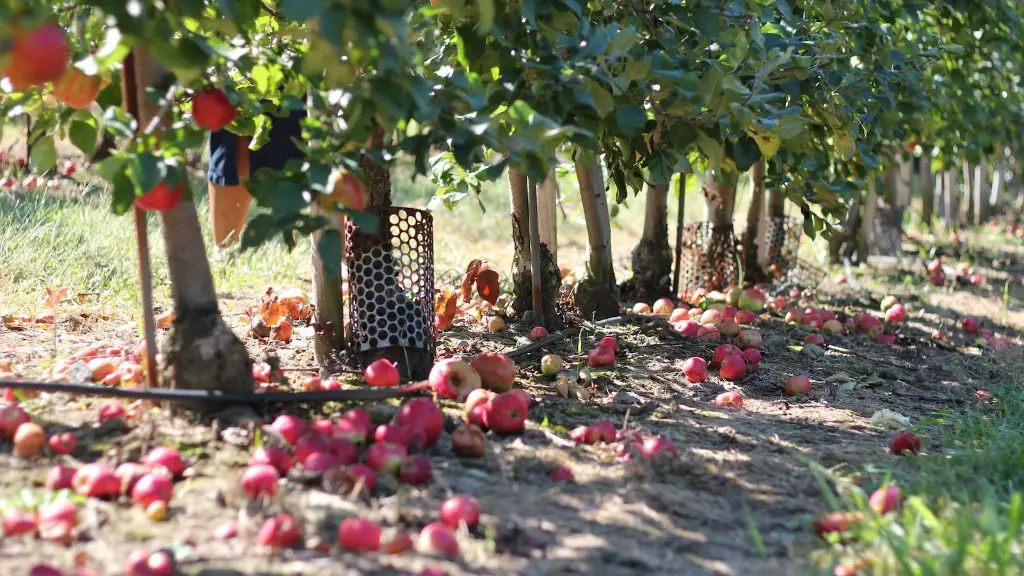Apples are a healthy and versatile fruit that have been harvested since the dawn of civilization. The best time to pick apples off a tree depends on various factors, including the type of apple tree, its age, when it was planted, and the desired use of the apples. The peak harvest time usually occurs when the apples are fully developed, which varies depending on the variety. Here is a closer look at when to pick apples off a tree.
The first step to knowing when to pick apples off a tree involves identifying the apple variety. Different apple varieties ripen at different times and must be picked at their peak of ripeness. Once the variety is known, the necessary research can be conducted to determine the typical ripening time of the variety.
It is also important to consider the age of the apple tree. Apples generally take three to five years to fully develop and reach their peak of ripeness. Newer apple trees may need more time than older trees. Additionally, if the tree was planted from a juvenile or seedling, it will naturally take longer than trees that were planted from a mature cutting.
The weather can also greatly influence when the apples are ready for harvesting. Warmer temperatures can speed up the ripening process, while cold temperatures can slow it down. Additionally, apples that are growing in cool to moderate climates may take longer to ripen than apples grown in warmer climates.
The desired use of the apples also plays a role in determining when to pick apples off a tree. Apples can be used for a variety of purposes, including eating, baking, and cider making. In general, apples used for eating or baking should be picked when they are fully ripe, while apples used for cider making can be harvested earlier.
Ultimately, the ideal time to pick apples off a tree depends on a variety of factors. Knowing the variety of apple, the age of the tree, the weather conditions, and the intended use of the apples can help give a general indication of when the apples should be harvested, allowing for successful apple picking.
Types of Apple Trees
There are three main types of apple trees, including standard, dwarf, and semi-dwarf. Standard apple trees can grow up to 35 feet tall and 15-20 feet wide, making them the largest of the three. This size can make harvesting apples much more challenging. Dwarf apple trees, on the other hand, are relatively small, typically growing to 8-10 feet tall and 8-10 feet wide. As a result, dwarf apples can often be harvested from the ground. Semi-dwarf apple trees are a good middle ground, growing to a height of 15-20 feet tall and 10-15 feet wide.
Storage
Once the apples have been harvested, it is important to store and take care of them properly. Apples are more likely to last longer and taste better if stored at around 32-35°F, which requires a special cooling compartment, such as a refrigerator with a fruit compartment. Alternatively, apples can be stored in a cool, dark place if refrigeration is not available. It is important not to store apples in the same area as vegetables or other fruits, as this can cause spoilage.
Uses
Apples can be used in many different forms, depending on their ripeness. Unripe apples are great for baking and can be used to make pies, cakes, muffins, or other baked goods. Ripe apples can be eaten fresh or used to make applesauce, apple butter, and other popular dishes. Additionally, overripe apples can be used to make cider or apple jelly. Apples can also be dried, frozen, or canned for later use.
Varieties
There are many different types of apples available for harvesting, each of which has its own unique attributes. Common varieties include Granny Smith, Delicious, Golden Delicious, Fuji, and Gala. Granny Smith apples are best for tart recipes, while Delicious apples are great for pies and other desserts. Golden Delicious apples are considered all-purpose apples, while Fuji and Gala are best for eating fresh or in salads.
Harvesting Tips
When harvesting apples, it is important to do so carefully to avoid damaging the tree or apples. Always use clean, sharp tools to avoid introducing any bacteria or viruses. When picking the apples, make sure to twist them gently and never pull them off the tree. To prevent bruising, be sure to place the apples in a basket or box rather than directly in a bag or container.
Nutritional Benefits
Apples are a versatile and nutritious fruit that offer a variety of health benefits. As well as being a great source of dietary fiber, apples are also packed with antioxidants, vitamins, and minerals. Apples are also high in polyphenols, which have been shown to reduce inflammation and support heart health. In addition, studies have also found that apples can help protect against certain cancers and help improve skin health.

